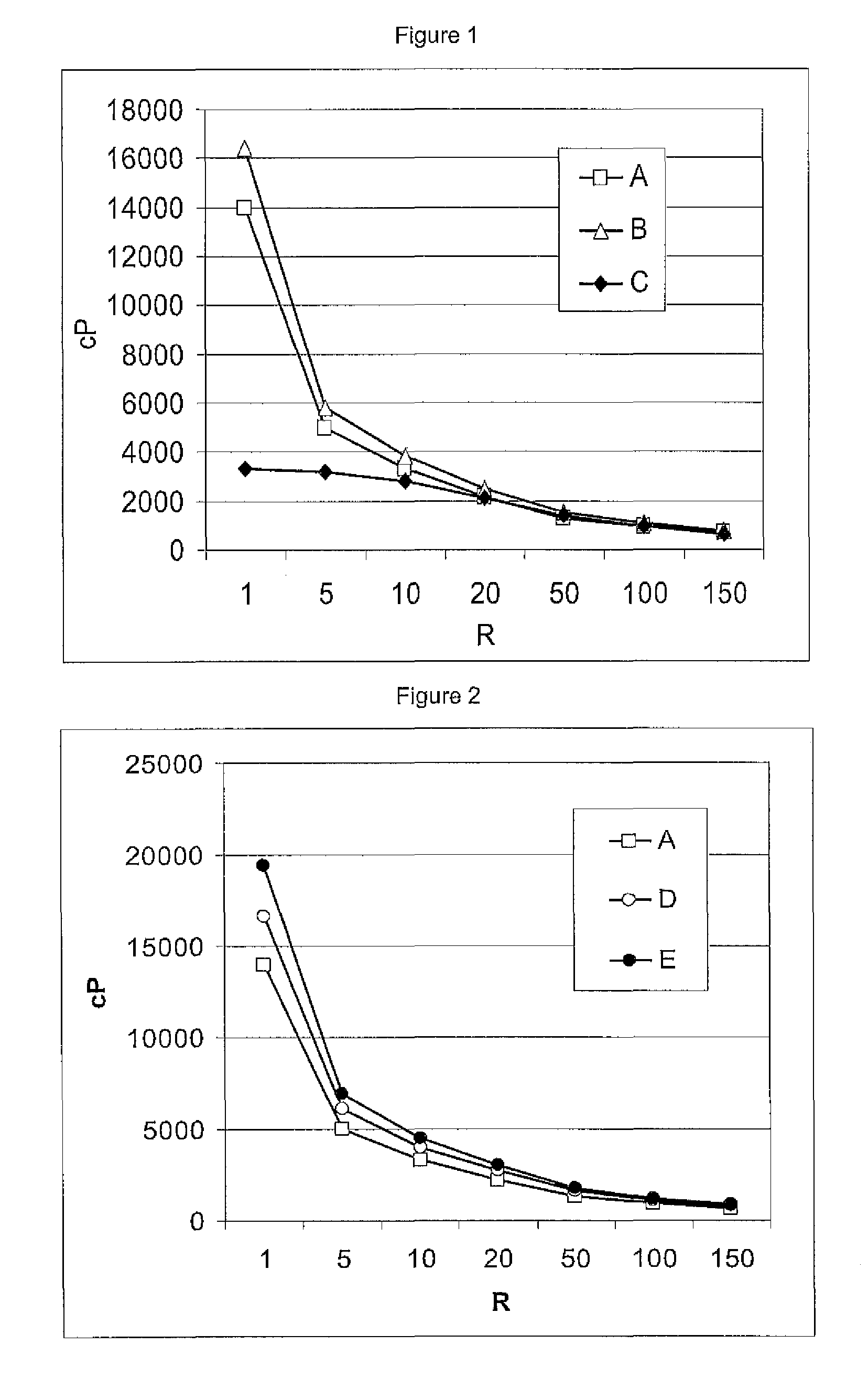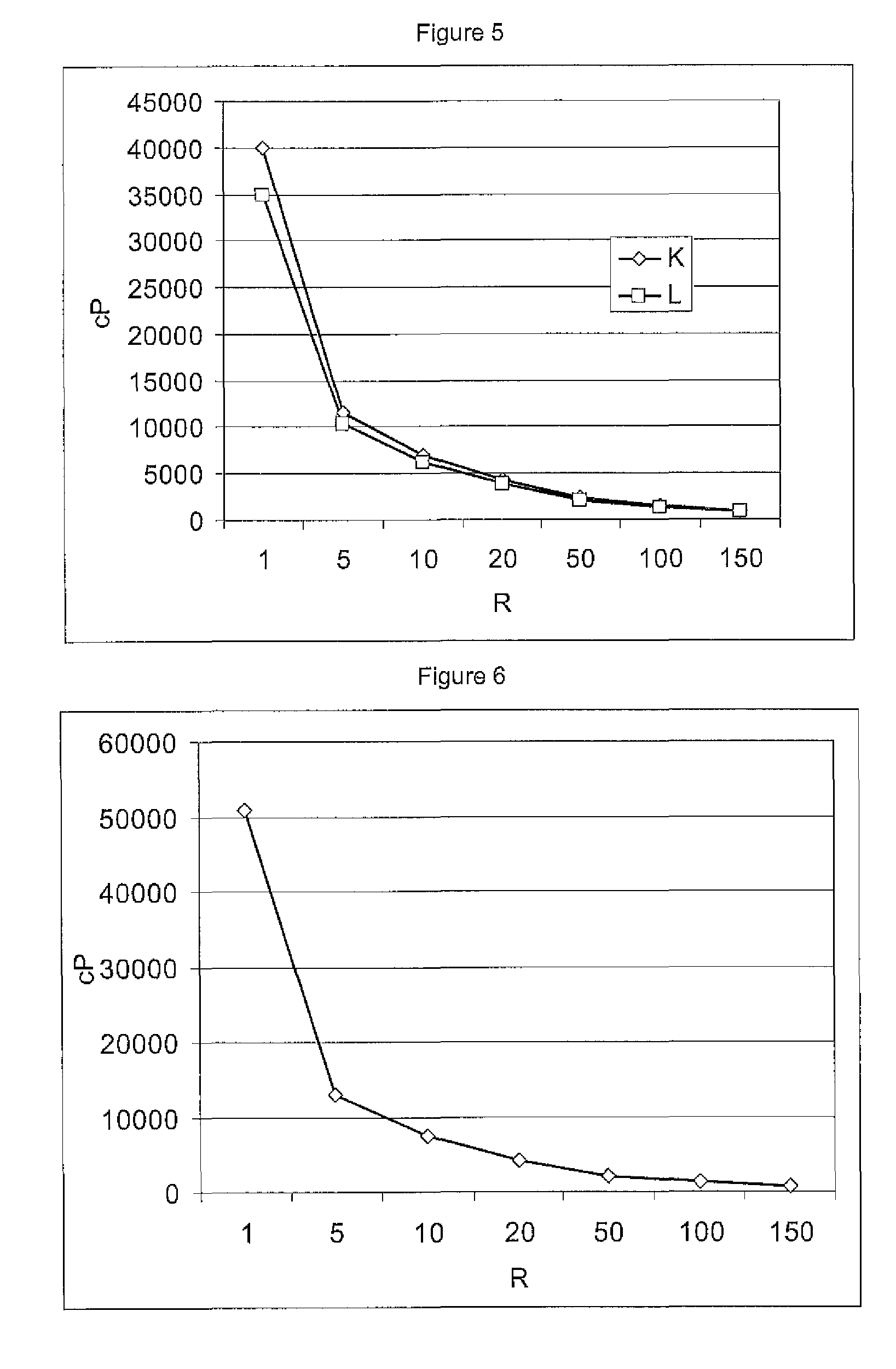Adhesive composition
a technology of adhesive composition and composition, applied in the field of adhesive composition, can solve the problems of inability to fully absorb caustic soda, etc., and achieve the effects of easy control and predictable, easy adjustment, and high product viscosity
- Summary
- Abstract
- Description
- Claims
- Application Information
AI Technical Summary
Benefits of technology
Problems solved by technology
Method used
Image
Examples
example 1
Conventional Stein-Hall Adhesive
[0148]A conventional Stein-Hall adhesive was produced as follows, based on modified wheat starch Mylbond 210 obtained from Syral SA. First a starch carrier was prepared by mixing 885 kg of water heated to 39° C. with 70 kg of the starch and 23.5 kg of NaOH solution at 29% wt strength. This mixture was stirred during 780 seconds in order to gelatinize the starch and to obtain a carrier. To this carrier were added 960 kg of secondary water, 416 kg of secondary starch and 4.4 kg of borax (sodium tetraborate decahydrate). This mixture was further mixed during 720 seconds. The adhesive composition C obtained had a dry solids content of 21% wt, a gel point of 54° C. and a Lorry cup viscosity at 30° C. of 14 seconds. The viscosity curve shown as C in FIG. 1 was determined. The curve shows viscosity expressed as mPa·s or cP against shear stress, in this case spindle speed R in rotations per minute (rpm). The curve was established using a Brookfield RV apparat...
example 2
Carbomer-Based Adhesives A and B
[0149]The carbomer used in this example was Carbopol 941 obtained from Lubrizol. Carbopol 941 may be described as a cross-linked polyacrylic acid polymer, available in powder form. When submitted to Gel Permeation Chromatography (GPC) dissolved in dimethylacetamide (DMA), the Carbopol 941 gave a spectrum showing a broad peak in between a retention window of 21 to almost 32 minutes which provided the following molecular weight information relative to DMA and on an analytical system which is calibrated with polymethylmethacrylate reference standards: an Mn of 96483, an Mw of 163802, resulting in a polydispersity Mw / Mn of 1.70, an MP of 114358 at a retention time of about 26 minutes, an Mz of 263738 and an Mz+1 of 379289.
Carbomer Gel Preparation
[0150]In an IKA magic LAB High Shear Mixer 40 grams of Carbopol 941 powder was mixed into 920 grams of water, and the pH was brought up to 6.8 by introducing 40 grams of NaOH solution of 29% wt strength.
Carbomer-B...
example 3
Carbomer-Based Adhesives D and E
Carbomer Gel Preparation
[0155]In an IKA magic LAB High Shear Mixer 40 grams of Carbopol 941 powder was mixed into 1000 grams of water, and the pH was brought up to 6.8 by introducing 40 grams of NaOH solution of 29% wt strength.
Carbomer-Based Adhesive Preparations
[0156]Native corn starch (220 grams) were mixed into 680 grams of water and stirred for 120 seconds. 100 grams of the carbomer gel were introduced and further mixed during 120 seconds in order to obtain adhesive D. The adhesive composition D obtained had a dry solids content of 22% wt, a gel point of 58° C. and a Lorry cup viscosity at 28° C. of 45 seconds. The viscosity curve was determined as in Example 1 and is shown as curve D in the figures. The viscosity curve was again determined on the same sample after 24 hrs, and is shown as curve E in the figures.
[0157]FIG. 2 compares the viscosity curves of the fresh carbomer-based adhesive A with the adhesives D and E which contain more gel but t...
PUM
| Property | Measurement | Unit |
|---|---|---|
| Brookfield viscosity | aaaaa | aaaaa |
| polydispersity | aaaaa | aaaaa |
| polydispersity | aaaaa | aaaaa |
Abstract
Description
Claims
Application Information
 Login to View More
Login to View More - R&D
- Intellectual Property
- Life Sciences
- Materials
- Tech Scout
- Unparalleled Data Quality
- Higher Quality Content
- 60% Fewer Hallucinations
Browse by: Latest US Patents, China's latest patents, Technical Efficacy Thesaurus, Application Domain, Technology Topic, Popular Technical Reports.
© 2025 PatSnap. All rights reserved.Legal|Privacy policy|Modern Slavery Act Transparency Statement|Sitemap|About US| Contact US: help@patsnap.com



